-
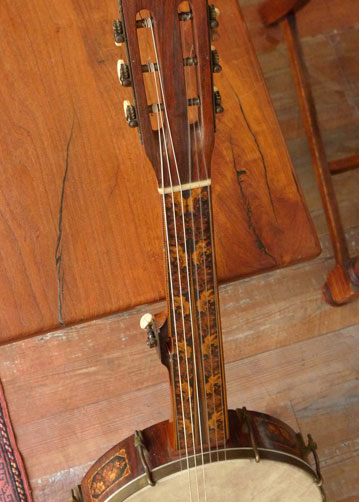 Read the full description below. If you're interested in this guitar, please call 512.922.8596 or contact us here.
Read the full description below. If you're interested in this guitar, please call 512.922.8596 or contact us here. -
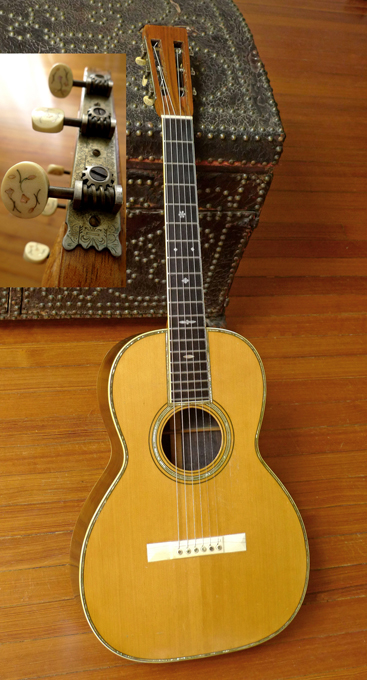 Exquisite, and a joy to play (… the top level, largest guitar that Martin made at the turn of the 20th century– with tone that shows off what Frank Henry Martin was proud of when he personally signed the inside of this instrument in April, 1903…)
Exquisite, and a joy to play (… the top level, largest guitar that Martin made at the turn of the 20th century– with tone that shows off what Frank Henry Martin was proud of when he personally signed the inside of this instrument in April, 1903…) -
 This fine Brazilian Rosewood 12-fret Martin is a joy to play, and it’s properly set up for steel strings. The grandson of C. F. Martin, Sr., Frank Henry Martin oversaw the Martin business from 1880 until well into twentieth century, and was responsible for the creation of the Style 0. I’m sure he loved this guitar–he personally signed the instrument, in cursive, under the top: “# 10082 Oct. 17th, 1905 F.H.M.” This 0-21 combines the exquisite tone of a 100 year old Martin, with some wonderful restoration. Guitar was refinished, probably decades ago, and it is a beautiful, French polish finish that has all the earmarks of an original finish. You can see the pores and saw marks in the Brazilian rosewood. No heavy-handed finish here, it’s a natural finish that lets the grain and color of the wood come through. And the tone, too, that sweet tone you can only get from Brazilian this old. The ebony pyramid bridge is a replacement, and features a compensated saddle, so intonation is dead on. (The bridge plate is the original small maple plate, in perfect condition.) Original tuners. Crack-free top and sides. There is only one very small crack, on the back, about 3 inches long, professionally repaired. The neck was set recently by Tony Nobles, and the original bar frets dressed. It plays, and sounds, like a late 20’s 12-fret Brazilian rosewood Martin.
This fine Brazilian Rosewood 12-fret Martin is a joy to play, and it’s properly set up for steel strings. The grandson of C. F. Martin, Sr., Frank Henry Martin oversaw the Martin business from 1880 until well into twentieth century, and was responsible for the creation of the Style 0. I’m sure he loved this guitar–he personally signed the instrument, in cursive, under the top: “# 10082 Oct. 17th, 1905 F.H.M.” This 0-21 combines the exquisite tone of a 100 year old Martin, with some wonderful restoration. Guitar was refinished, probably decades ago, and it is a beautiful, French polish finish that has all the earmarks of an original finish. You can see the pores and saw marks in the Brazilian rosewood. No heavy-handed finish here, it’s a natural finish that lets the grain and color of the wood come through. And the tone, too, that sweet tone you can only get from Brazilian this old. The ebony pyramid bridge is a replacement, and features a compensated saddle, so intonation is dead on. (The bridge plate is the original small maple plate, in perfect condition.) Original tuners. Crack-free top and sides. There is only one very small crack, on the back, about 3 inches long, professionally repaired. The neck was set recently by Tony Nobles, and the original bar frets dressed. It plays, and sounds, like a late 20’s 12-fret Brazilian rosewood Martin. -
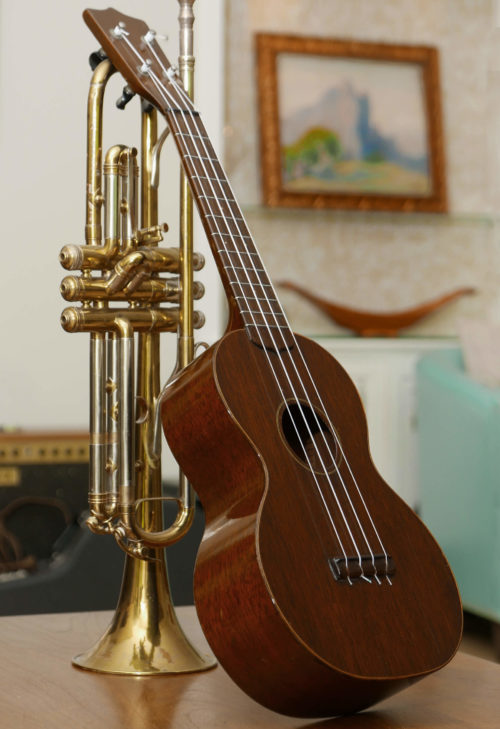 A beautiful example of one of the rarest prewar Martin ukuleles. This is a prewar Martin C-1. (All Concert Model ukuleles from Martin– with the exception of few special orders– were style 1). Officially called the Concert model ukulele, it’s larger than the many soprano size ukes. It’s very rare to find a prewar C-1 on the market– and much rarer still to find a pre-1933. This instrument was made between 1925 and 1933– because of the Martin stamp on the back of the headstock and the lack of the (post-1933) Martin decal on the front of the headstock. This is currently the only Martin C-1 from the late 1920’s on the market. And the tone and playability are perfect. Louder, and more bell like tone than a Martin Style 1 soprano uke. Martin concert ukuleles are the same body size as taropatch (1918-1932) but with four strings only. While the taropatch had been offered with four strings since its introduction, the new concert model was different in that it had a narrower neck and a standard soprano-size bridge. It was added to the standard catalog that year and by 1927 it was outselling all taropatch models combined. Concerts ukuleles are tuned the same as the sopranos but because of the larger body have a deeper and richer sound, and a slightly longer, easier to play scale length of 14 3/4". The Concert Ukulele from Martin–while rare to find a prewar example– is considered the ideal size for players– larger than the tiny soprano but not too big like the Martin Tenor uke. This one has a rich, beautiful tone, and it’s almost unplayed condition. The action is perfect. There is one small crack on top–but it’s essentially “cleated” by the orignal bridde plate and does not need addressing, and a smaller finish crack that does not go through to the inside). The braces and all else inside: pristine. And it even comes in its original canvas case. Like most Martin ukes, the mahogany bridge had some wear on the string slots. So we created a new, replacement, 100% historically correct replacement bridge. Original patent tuners Original ebony nut Brazilian rosewood fretboard Style 1: all mahogany, with brazilian binding on top Total length: 23 ¼ inches Body length: 11 inches Body width upper bout: 5 ¾ inches Body width lower bout: 7 5/8 inches Scale length: 14 ¾ inches Price: with original case. $2150.
A beautiful example of one of the rarest prewar Martin ukuleles. This is a prewar Martin C-1. (All Concert Model ukuleles from Martin– with the exception of few special orders– were style 1). Officially called the Concert model ukulele, it’s larger than the many soprano size ukes. It’s very rare to find a prewar C-1 on the market– and much rarer still to find a pre-1933. This instrument was made between 1925 and 1933– because of the Martin stamp on the back of the headstock and the lack of the (post-1933) Martin decal on the front of the headstock. This is currently the only Martin C-1 from the late 1920’s on the market. And the tone and playability are perfect. Louder, and more bell like tone than a Martin Style 1 soprano uke. Martin concert ukuleles are the same body size as taropatch (1918-1932) but with four strings only. While the taropatch had been offered with four strings since its introduction, the new concert model was different in that it had a narrower neck and a standard soprano-size bridge. It was added to the standard catalog that year and by 1927 it was outselling all taropatch models combined. Concerts ukuleles are tuned the same as the sopranos but because of the larger body have a deeper and richer sound, and a slightly longer, easier to play scale length of 14 3/4". The Concert Ukulele from Martin–while rare to find a prewar example– is considered the ideal size for players– larger than the tiny soprano but not too big like the Martin Tenor uke. This one has a rich, beautiful tone, and it’s almost unplayed condition. The action is perfect. There is one small crack on top–but it’s essentially “cleated” by the orignal bridde plate and does not need addressing, and a smaller finish crack that does not go through to the inside). The braces and all else inside: pristine. And it even comes in its original canvas case. Like most Martin ukes, the mahogany bridge had some wear on the string slots. So we created a new, replacement, 100% historically correct replacement bridge. Original patent tuners Original ebony nut Brazilian rosewood fretboard Style 1: all mahogany, with brazilian binding on top Total length: 23 ¼ inches Body length: 11 inches Body width upper bout: 5 ¾ inches Body width lower bout: 7 5/8 inches Scale length: 14 ¾ inches Price: with original case. $2150. -
Out of stock
 This guitar is a masterfully crafted interpretation of the fabled Roy Smeck, a slope-shouldered Gibson acoustic from the 1930s, which pairs a 12-fret neck with a standard, slope shouldered body, in Brazilian rosewood. From Charlottesville, Virginia-based Rockbridge -- one of the country’s most intriguing and masterful boutique luthiers. In a custom Cedar Creek case. Read the full description below. If you're interested in this guitar, please call 512.922.8596 or contact us here.
This guitar is a masterfully crafted interpretation of the fabled Roy Smeck, a slope-shouldered Gibson acoustic from the 1930s, which pairs a 12-fret neck with a standard, slope shouldered body, in Brazilian rosewood. From Charlottesville, Virginia-based Rockbridge -- one of the country’s most intriguing and masterful boutique luthiers. In a custom Cedar Creek case. Read the full description below. If you're interested in this guitar, please call 512.922.8596 or contact us here. -
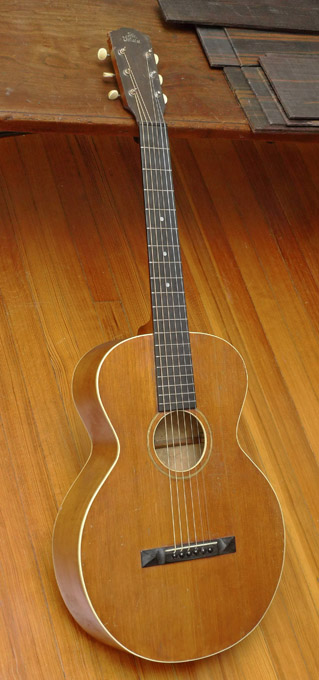 This historically significant Gibson L-1, 12-fret flat top guitar, is the earliest true Gibson flat top guitar on the market today. As well as the one in the best, original condition. And it is a rare example, exhibiting transitional features that place it just barely after the 1926 introduction– yet still a 1926 model (Factory order number: 8406)– but leaning toward a few subsequent, very early changes that would establish Gibson on the flat top scene that Martin had carved out so well. Introduced in '26 (there was already a L-1 archtop), the original Gibson L-1 flat top had a 13-1/2" body, wide V-neck, and H-bracing. The L-1 later achieved fame due to its association with the legendary bluesman Robert Johnson. Its rounded lower bout, combined with narrow waist, is distinctive. And its thin braces, thin finish, and thin woods give it a wonderful woody yet loud, cutting, bluesy tone that no 1930’s– much less more modern– Gibson or Martin could achieve. It is the transitional nature of this particular guitar, that is intriguing. The very first L-1 flat top, had an arched back (birch, or maple), and a pretty fat V-shaped neck. Other traits of the very first L-1 flat top: single bound top; maple back and sides; no truss rod; unbound ebony fingerboard; H pattern top bracing; “The Gibson” paint logo straight across peghead; light amber top finish; Sheraton brown finish on back and sides; single bound back. But this L-1, though very early, does not have arched back, but rather a true flat top-style back. And its neck is a great-playing C shape, not overly fat, and not a V shape. Furthermore, it has “A” bracing, not the standard H bracing. Finally, this guitar has a (original) ebony fretboard with virtually no radius. It’s a true “transition” example. It is notably not a hybrid put together from old L-1 archtop parts– as were the very first L-1 “flat tops” out of the gate in 1926. These are the traits of this early Gibson L-1 flat top:
This historically significant Gibson L-1, 12-fret flat top guitar, is the earliest true Gibson flat top guitar on the market today. As well as the one in the best, original condition. And it is a rare example, exhibiting transitional features that place it just barely after the 1926 introduction– yet still a 1926 model (Factory order number: 8406)– but leaning toward a few subsequent, very early changes that would establish Gibson on the flat top scene that Martin had carved out so well. Introduced in '26 (there was already a L-1 archtop), the original Gibson L-1 flat top had a 13-1/2" body, wide V-neck, and H-bracing. The L-1 later achieved fame due to its association with the legendary bluesman Robert Johnson. Its rounded lower bout, combined with narrow waist, is distinctive. And its thin braces, thin finish, and thin woods give it a wonderful woody yet loud, cutting, bluesy tone that no 1930’s– much less more modern– Gibson or Martin could achieve. It is the transitional nature of this particular guitar, that is intriguing. The very first L-1 flat top, had an arched back (birch, or maple), and a pretty fat V-shaped neck. Other traits of the very first L-1 flat top: single bound top; maple back and sides; no truss rod; unbound ebony fingerboard; H pattern top bracing; “The Gibson” paint logo straight across peghead; light amber top finish; Sheraton brown finish on back and sides; single bound back. But this L-1, though very early, does not have arched back, but rather a true flat top-style back. And its neck is a great-playing C shape, not overly fat, and not a V shape. Furthermore, it has “A” bracing, not the standard H bracing. Finally, this guitar has a (original) ebony fretboard with virtually no radius. It’s a true “transition” example. It is notably not a hybrid put together from old L-1 archtop parts– as were the very first L-1 “flat tops” out of the gate in 1926. These are the traits of this early Gibson L-1 flat top:- Single bound, red spruce top, with amber stain
- Original ebony bridge; original cellulose bridge pins (unslotted)
- Maple back and sides (back is not arched), with Sheraton brown finish
- Mahogany neck, C-shaped
- Original, very thin maple bridge plate, tucked under braces, and extending all the way to the kerfing at the sides of the top, and tucked under the Kerfing
- No truss rod
- Unbound ebony fingerboard (not “ebonized”, but solid ebony)
- “The Gibson” paint logo straight across peghead
- Single bound (ivoroid) top
- Single bound (ivoroid) back
- H bracing (a slight variation of “A” bracing; with the apex at either side of the neck block– and the braces actually tuck beneath the neck block)
- Pearl dots on 5,7, and 9 frets
- Original three-on-a-plate tuners, with plastic tuner buttons
- Original frets
- Original ebony nut
- 13 5/8 inch, lower bout
- 24 1/2 inch scale (not the 25 inch scale that was soon settled on by Gibson for the L-1, soon after the introduction)
- Nut width: just shy of 1 7/8 inch
- Width of fretboard at 12th fret: 2 ¼ inch
- String spacing at nut: a hair over 1 ½ inch
- String spacing at bridge: 2 3/8 inch
- Three well-repaired top cracks (all, with the grain; and the amber finish on top is very forgiving, in terms of appearance, so cracks are hardly visible)
- One replaced tuner post
-
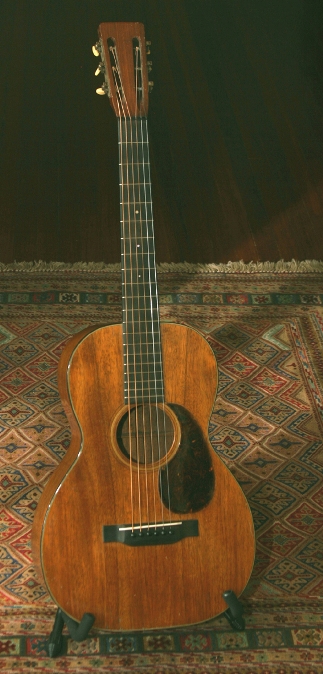 We converted this Golden Era 12-fret Koa Martin from the original Hawaiian setup ourselves, so it's perfect. The instrument does not have a crack anywhere. All original finish. Original Ebony bridge, converted from the tall Hawaiian set-up to a normal 30's set-up. Same with the ebony nut. All new, period-perfect Bar Frets. We radiused the ebony fretboard to 30's Martin specs. Neck was set and action is perfect. 1-7/8 inch nut width. Original tuners. Original bridge plate. Minor nicks and dings on top and back, but with the all original finish and crack-free, it's a rare specimen. Nothing compares in tone to an all-Koa Golden Age Martin. Koa blends the midrange of mahogany with the top end of maple-or, in the case of a fine 30's Koa Martin- hints of Brazilian rosewood. This fine 0-18K has all you would want from a Koa Martin, with the clearest, bell-like treble string tone imaginable.
We converted this Golden Era 12-fret Koa Martin from the original Hawaiian setup ourselves, so it's perfect. The instrument does not have a crack anywhere. All original finish. Original Ebony bridge, converted from the tall Hawaiian set-up to a normal 30's set-up. Same with the ebony nut. All new, period-perfect Bar Frets. We radiused the ebony fretboard to 30's Martin specs. Neck was set and action is perfect. 1-7/8 inch nut width. Original tuners. Original bridge plate. Minor nicks and dings on top and back, but with the all original finish and crack-free, it's a rare specimen. Nothing compares in tone to an all-Koa Golden Age Martin. Koa blends the midrange of mahogany with the top end of maple-or, in the case of a fine 30's Koa Martin- hints of Brazilian rosewood. This fine 0-18K has all you would want from a Koa Martin, with the clearest, bell-like treble string tone imaginable. -
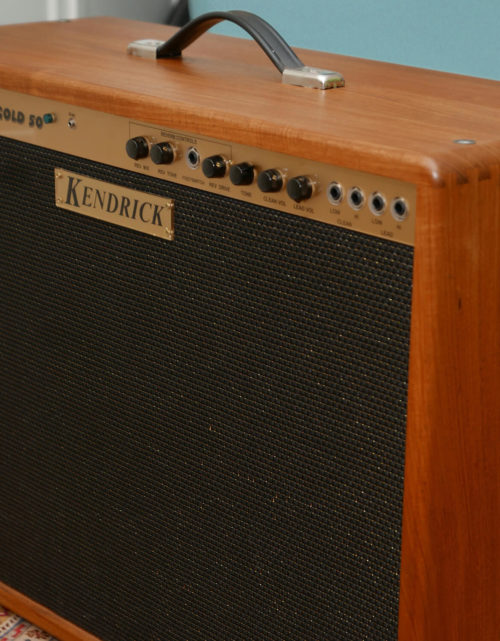 This was one of the best amps ever made by the legendary Gerald Weber. All-tube circuitry, designed and made in the USA, by Weber. It not only has power to spare (50 watts), but its unique circuitry has two channels, clean and lead, with different preamp circuit. These channels can be blended through patching the second input of one channel into the first input of the other, for purposes of blending the two channels together and further tone shaping with the interactive tone circuit. The bottom line: Tons of power if you need it, but the ability to get all the creamy, lush lead tones with the lead channel and/or blending. You just have to hear it. Original, handmade hardwood cabinet. 2 x 12: one 12 inch Kendrick brown frame and one 12 inch Kendrick black frame speaker. Kendrick's double spring reverb with three controls. Great condition. Recently serviced by one of the best amp techs in Texas. Price: $1495. No shipping. Local pickup only in Austin.
This was one of the best amps ever made by the legendary Gerald Weber. All-tube circuitry, designed and made in the USA, by Weber. It not only has power to spare (50 watts), but its unique circuitry has two channels, clean and lead, with different preamp circuit. These channels can be blended through patching the second input of one channel into the first input of the other, for purposes of blending the two channels together and further tone shaping with the interactive tone circuit. The bottom line: Tons of power if you need it, but the ability to get all the creamy, lush lead tones with the lead channel and/or blending. You just have to hear it. Original, handmade hardwood cabinet. 2 x 12: one 12 inch Kendrick brown frame and one 12 inch Kendrick black frame speaker. Kendrick's double spring reverb with three controls. Great condition. Recently serviced by one of the best amp techs in Texas. Price: $1495. No shipping. Local pickup only in Austin. -
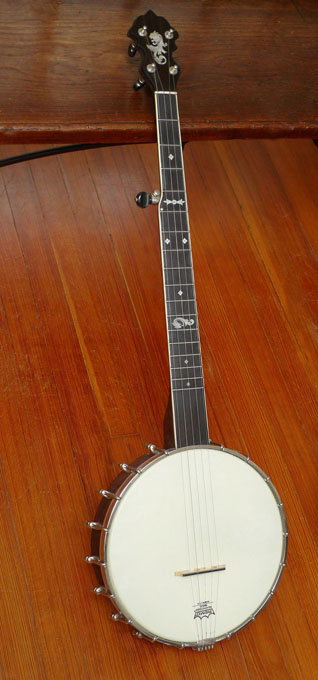 This is a one-of-a-kind custom banjo, from one of the country’s most respected luthiers, based in Appomattox, Virginia. I love this banjo for picking on the couch– it won’t put your back out, picking it up and putting it down, or crush your cat or your sweetheart. It’s lightweight, and with a custom-size head. But it packs beautiful full tone, not the tinny nasal sound from most open back banjos. It’s five or so years old, but with very little wear.
This is a one-of-a-kind custom banjo, from one of the country’s most respected luthiers, based in Appomattox, Virginia. I love this banjo for picking on the couch– it won’t put your back out, picking it up and putting it down, or crush your cat or your sweetheart. It’s lightweight, and with a custom-size head. But it packs beautiful full tone, not the tinny nasal sound from most open back banjos. It’s five or so years old, but with very little wear.- Dark stained maple rim, and neck
- 11 inch pot
- Ebony fretboard
- Engraved dragon inlay in peghead
- Custom MOP inlays
- Bound neck
- No Knot tail piece (Pat. Nov. 19 1901)
- 18 lug
- Brass hoop tone ring
- Dowell stick construction
- nut width 1-¼ inch
- scale: 25- ½ inches
- maple rim diameter: 10- ½ outside
- maple rim thickness: 7/16 inches
- Dark stained maple rim, and neck
- 11 inch pot
- Ebony fretboard
- Engraved dragon inlay in peghead
- Custom MOP inlays
- Bound neck
- No Knot tail piece (Pat. Nov. 19 1901)
- 18 lug
- Brass hoop tone ring
- Dowell stick construction
- nut width 1-¼ inch
- scale: 25-½ inches
- maple rim diameter: 10- ½ outside
- maple rim thickness: 7/16 inches
- With original case.
-
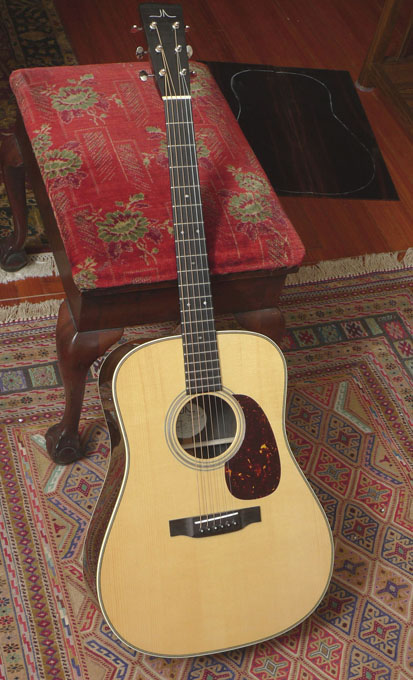 This is a new Allison Brazilian Rosewood dreadnought. Austin-based John Allison was a key part of the Collings Guitar team for years. John is now one of the most sought-after independent makers of fine instruments in the southwest. His guitars are carried by a number of top dealers in the U.S… and we’ve just snagged this brand new, wonderful Brazilian– a custom order guitar. Allison’s attention to detail is astounding. You just have to see and play this great brazilian. Right off the bench, it’s loud and beguiling, and it will only get better over time.
This is a new Allison Brazilian Rosewood dreadnought. Austin-based John Allison was a key part of the Collings Guitar team for years. John is now one of the most sought-after independent makers of fine instruments in the southwest. His guitars are carried by a number of top dealers in the U.S… and we’ve just snagged this brand new, wonderful Brazilian– a custom order guitar. Allison’s attention to detail is astounding. You just have to see and play this great brazilian. Right off the bench, it’s loud and beguiling, and it will only get better over time.- Top: Adirondack Spruce
- Back, and Sides: Brazilian Rosewood
- Bracing: Scalloped X, Adirondack
- Neck: Mahogany
- Finish: Nitrocellulose lacquer
- Herringbone purfling
- Ivoroid binding
- Fretboard: Ebony
- Bridge: Ebony
- Peghead veneer: Ebony
- Scale Length: 25.5 inches
- Nut Width: 1 11/16 inches
- Tuners: Waverly
-
 The Larson Brothers of Chicago never marketed any guitar, throughout their long career, that was marked “Larson”. Their designs were branded by Maurer, Stahl, Prarie State, Stetson, and a few other guitar makers– but never “Larson”. They were also known for making many “off-catalog” guitars, i.e. guitars with combinations of features that varied from the Maurer, Stahl, etc, catalogs, and guitars that were not marked at all with a brand. This guitar is a Larson Bros creation that is not marked at all. It is a custom made instrument–but it has all the typical Larson hallmarks. The tone of this Larson is every bit as wonderful as the Maurer/Larson listed above, indeed it is quite similar, due to the same patented “built under tension” design, and X-bracing. This Larson does not have laminated braces (it’s well documented that laminated braces were only used on certain models–and their use was not related to level or price.) Every part of this guitar is original, including original finish. There are two repaired cracks on the back, and three small, repaired cracks on top.
The Larson Brothers of Chicago never marketed any guitar, throughout their long career, that was marked “Larson”. Their designs were branded by Maurer, Stahl, Prarie State, Stetson, and a few other guitar makers– but never “Larson”. They were also known for making many “off-catalog” guitars, i.e. guitars with combinations of features that varied from the Maurer, Stahl, etc, catalogs, and guitars that were not marked at all with a brand. This guitar is a Larson Bros creation that is not marked at all. It is a custom made instrument–but it has all the typical Larson hallmarks. The tone of this Larson is every bit as wonderful as the Maurer/Larson listed above, indeed it is quite similar, due to the same patented “built under tension” design, and X-bracing. This Larson does not have laminated braces (it’s well documented that laminated braces were only used on certain models–and their use was not related to level or price.) Every part of this guitar is original, including original finish. There are two repaired cracks on the back, and three small, repaired cracks on top.- Lower bout width: 12 5/8 inches
- Brazilian rosewood back and sides
- Ivory celluloid Bound fretboard
- Ivory celluloid Bound headstock
- Spruce top
- X braced
- Larson’s patented “built under tension” design
- Rosette: Abalone pearl and wood inlay bordering the sound hole
- Radiused ebony fingerboard, and Classic Larson Brothers’ “ebony below the binding”
- Engraved inlays on fretboard
- Original tuners
- Original ebony bridge
- Original bridge pins
- 1-7/8" wide nut
- 2 1/4" bridge string spacing
- 24.3" scale length
- One-piece mahogany neck, round C shaped neck profile.
-
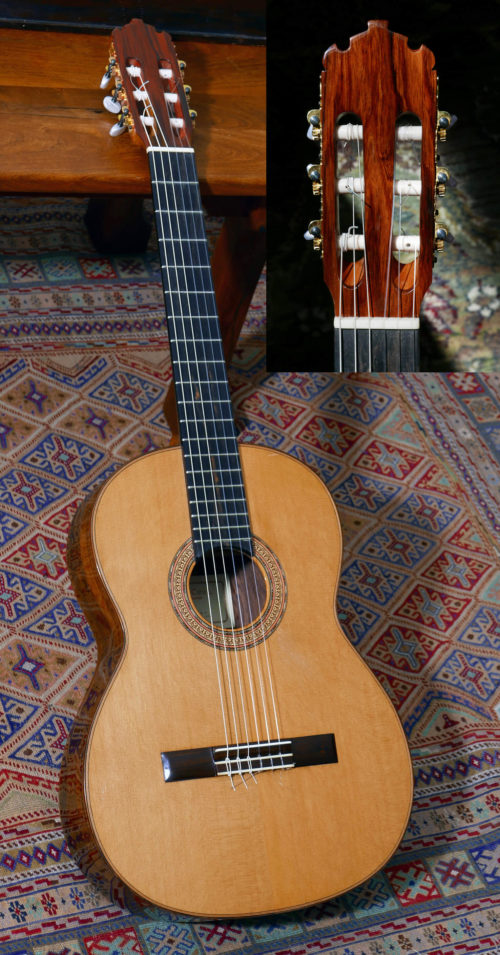 Acquired from the original owner – who bought this wonderful instrument directly from David Caro in the mountain town of the maker, one of the best luthiers that Paracho, Mexico has ever produced – in the mid 90’s and hand-carried it to California where it was lightly played. And it remains in remarkable original condition. The maker is David Caro, also known as David Caro Leonardo, or David Caro L. (In Mexico, the last/last name, in this case “Leonardo”, is the mother’s maiden name that is formally added after a person’s last [paternal] name but typically dropped in all but formal situations, documents etc.) Caro’s best instruments are among the best of a small, elite group that honed their craft at the top levels, and also benefited from visits and master classes given in Paracho by some world class luthiers from Spain, Germany, and the USA such as Felix Manzanero, Antonio Raya Pardo, Jose Romanillos, Thomas Humphery, and Herman Hauser III. Only a few Paracho luthiers have stood out over the years – Jose Navarro, Arturo Huipe, Abel Garcia, Enos Hernandez (his best work), German Vasquez Rubio, and Caro among them. See the enclosed photos from Fretboard Journal magazine, Spring 2008, that featured David Caro prominently in the feature article in that issue on Paracho luthiers. Paracho is an originally Tarascan village that sits in a high valley at 7,300 feet altitude, in the state of Michoacán, a relatively little visited state but renowned for its diversity and great beauty – and for some of the best classical guitar luthiers in the Americas. It extends from the Pacific coast, and is crossed by the Sierra Madre Del Sur in its southern part and by high volcanic mountains in its northern axis. When this guitar was made, in 1996, David Caro was at the height of his craft. And soon after, he was the first luthier to be added to the GSA calendar. This instrument is among the very best guitars ever made by Caro. And we love the model designation, it’s signed by hand on the label, “Mdo. 500”, i.e. “model 500” – sounds like a sports car name. Model 500 was the top model from Caro, in 1995/96 – using top woods, and also the best bindings, and all details. In those years, Caro’s best concert instruments went from model 100 at the base level, then ascending in tone woods and overall construction details to 200, 300, 400, then reaching the top level of “500”. So we’re calling this instrument, “el Quinientos”. (Spanish for “the 500” – nice ring to that – it’s pronounced “key-knee-éntose”) Several things make this guitar stand out as a gem: • It’s the top model from this luthier in the 1990’s • The great original condition • Scale length of 648mm. This scale length is reminiscent of Herman Hauser I’s guitars, and is firmly in the school of the shorter 650 range, not the longer scale lengths that crept in, in the last quarter of the 20th century. This is a great scale length – and note the nut width is a typical nut width of a full size classical guitar. And the neck thickness is great – on the thinner side. This combination makes it a joy to play and so easy to play – but the tone is superb. The full tone, and volume are better than most longer scale guitars. • Light weight/construction, that really allows it to sing. Its total weight, with strings, is a remarkably lithe 1430 grams • And it has great combination of woods: • Palo Escrito back and sides, bridge, and headplate veneer. DALBERGIA PALOESCRITO, is a true rosewood, a great wood that over the years came to be favored by the top luthiers in Paracho – for their top models. It sounds like Brazilian rosewood, but a tad different, and it’s not as “dark” in tone as Indian rosewood. Palo Escrito is lighter in weight and density than either brazilian or Indian rosewood. And weight, is of course part of the equation of a guitar that does translate to tone. Palo Escrito makes this guitar really breathe, and resonate. The lighter weight of this guitar is its charm, that translates to tone – slightly more airy and open, less “closed”, and with full round basses. The tone is clear, with superb string separation, as from the best spruce over rosewood guitars. Surprising volume – but it perhaps produces the best tone, in more delicate playing where you want each note to stand out – that’s of course called good “string separation”: the notes in a run or chord don’t all “blend together” but each note is discernable. And we think it’s accurate to say that this guitar, with its light weight and 648 scale length and combination of woods, has a tone that leans to a great Flamenco negra tone. Fast attack on the trebles, with a touch of growl in the bass when you play them hard. Yet the guitar responds very well to a light touch as well. If you’re looking for another ho-hum, non-descript spruce over Indian rosewood classical tone, this instrument is not for you. • Spruce top – European Alpine spruce • Ebony fingerboard • Ebony reinforcing strips, back of neck • Ebony heel cap • Beautiful rosette, with a hearts & rope pattern (another homage to Bernabe). • Palo Escrito is also used in the binding, back center strip, tie block, and purfling • The headstock shape is an homage to Paulino Bernabe. • Fan strutting, with 5 braces. The braces are very thin, and also scalloped – contributing to the great tone of the instrument. The scale length of the guitar, if it's not on the longer side, allows the luthier to be use more delicate bracing, adding to tone. (Longer scale length guitars produce more tension on the top due to the higher string tension inherent in a longer scale, so luthiers typically have to brace more strongly with longer scale lengths.) • And there is unique, 2-rosewood cleat application under the bridge – one cleat added by Caro at time of construction, on either end of the bridge, on the underside of top, for stability of the top wood beneath the bridge ends. It's worked well. • Good saddle height– and the neck is very straight, and there will never be any neck bowing issues or issue with too high action. Condition: 100% crack-free All original, thin lacquer finish Frets, and fretboard show very little wear A few nicks and dings, and a small amount of fingernail marks in the “pick guard” area. Overall, the condition is what you’d expect from an instrument that’s been played, carefully, for maybe a year, not 20+ years. But the tone is aged, open, clear – benefiting from more than two decades of aging and drying of the woods. Scale length: 648mm Nut Width: 52mm (2 2/32 inches) String spacing at nut: 45mm (1 ¾ inches) Width at lower bout: 14 ¼ inches Body depth, at bottom: 4 inches Body depth, at neck/body joint: 3 ¾ inches Weight (fully strung): 1430 grams (3.15 pounds) In a modern, hard shell case. Price: $4,750.
Acquired from the original owner – who bought this wonderful instrument directly from David Caro in the mountain town of the maker, one of the best luthiers that Paracho, Mexico has ever produced – in the mid 90’s and hand-carried it to California where it was lightly played. And it remains in remarkable original condition. The maker is David Caro, also known as David Caro Leonardo, or David Caro L. (In Mexico, the last/last name, in this case “Leonardo”, is the mother’s maiden name that is formally added after a person’s last [paternal] name but typically dropped in all but formal situations, documents etc.) Caro’s best instruments are among the best of a small, elite group that honed their craft at the top levels, and also benefited from visits and master classes given in Paracho by some world class luthiers from Spain, Germany, and the USA such as Felix Manzanero, Antonio Raya Pardo, Jose Romanillos, Thomas Humphery, and Herman Hauser III. Only a few Paracho luthiers have stood out over the years – Jose Navarro, Arturo Huipe, Abel Garcia, Enos Hernandez (his best work), German Vasquez Rubio, and Caro among them. See the enclosed photos from Fretboard Journal magazine, Spring 2008, that featured David Caro prominently in the feature article in that issue on Paracho luthiers. Paracho is an originally Tarascan village that sits in a high valley at 7,300 feet altitude, in the state of Michoacán, a relatively little visited state but renowned for its diversity and great beauty – and for some of the best classical guitar luthiers in the Americas. It extends from the Pacific coast, and is crossed by the Sierra Madre Del Sur in its southern part and by high volcanic mountains in its northern axis. When this guitar was made, in 1996, David Caro was at the height of his craft. And soon after, he was the first luthier to be added to the GSA calendar. This instrument is among the very best guitars ever made by Caro. And we love the model designation, it’s signed by hand on the label, “Mdo. 500”, i.e. “model 500” – sounds like a sports car name. Model 500 was the top model from Caro, in 1995/96 – using top woods, and also the best bindings, and all details. In those years, Caro’s best concert instruments went from model 100 at the base level, then ascending in tone woods and overall construction details to 200, 300, 400, then reaching the top level of “500”. So we’re calling this instrument, “el Quinientos”. (Spanish for “the 500” – nice ring to that – it’s pronounced “key-knee-éntose”) Several things make this guitar stand out as a gem: • It’s the top model from this luthier in the 1990’s • The great original condition • Scale length of 648mm. This scale length is reminiscent of Herman Hauser I’s guitars, and is firmly in the school of the shorter 650 range, not the longer scale lengths that crept in, in the last quarter of the 20th century. This is a great scale length – and note the nut width is a typical nut width of a full size classical guitar. And the neck thickness is great – on the thinner side. This combination makes it a joy to play and so easy to play – but the tone is superb. The full tone, and volume are better than most longer scale guitars. • Light weight/construction, that really allows it to sing. Its total weight, with strings, is a remarkably lithe 1430 grams • And it has great combination of woods: • Palo Escrito back and sides, bridge, and headplate veneer. DALBERGIA PALOESCRITO, is a true rosewood, a great wood that over the years came to be favored by the top luthiers in Paracho – for their top models. It sounds like Brazilian rosewood, but a tad different, and it’s not as “dark” in tone as Indian rosewood. Palo Escrito is lighter in weight and density than either brazilian or Indian rosewood. And weight, is of course part of the equation of a guitar that does translate to tone. Palo Escrito makes this guitar really breathe, and resonate. The lighter weight of this guitar is its charm, that translates to tone – slightly more airy and open, less “closed”, and with full round basses. The tone is clear, with superb string separation, as from the best spruce over rosewood guitars. Surprising volume – but it perhaps produces the best tone, in more delicate playing where you want each note to stand out – that’s of course called good “string separation”: the notes in a run or chord don’t all “blend together” but each note is discernable. And we think it’s accurate to say that this guitar, with its light weight and 648 scale length and combination of woods, has a tone that leans to a great Flamenco negra tone. Fast attack on the trebles, with a touch of growl in the bass when you play them hard. Yet the guitar responds very well to a light touch as well. If you’re looking for another ho-hum, non-descript spruce over Indian rosewood classical tone, this instrument is not for you. • Spruce top – European Alpine spruce • Ebony fingerboard • Ebony reinforcing strips, back of neck • Ebony heel cap • Beautiful rosette, with a hearts & rope pattern (another homage to Bernabe). • Palo Escrito is also used in the binding, back center strip, tie block, and purfling • The headstock shape is an homage to Paulino Bernabe. • Fan strutting, with 5 braces. The braces are very thin, and also scalloped – contributing to the great tone of the instrument. The scale length of the guitar, if it's not on the longer side, allows the luthier to be use more delicate bracing, adding to tone. (Longer scale length guitars produce more tension on the top due to the higher string tension inherent in a longer scale, so luthiers typically have to brace more strongly with longer scale lengths.) • And there is unique, 2-rosewood cleat application under the bridge – one cleat added by Caro at time of construction, on either end of the bridge, on the underside of top, for stability of the top wood beneath the bridge ends. It's worked well. • Good saddle height– and the neck is very straight, and there will never be any neck bowing issues or issue with too high action. Condition: 100% crack-free All original, thin lacquer finish Frets, and fretboard show very little wear A few nicks and dings, and a small amount of fingernail marks in the “pick guard” area. Overall, the condition is what you’d expect from an instrument that’s been played, carefully, for maybe a year, not 20+ years. But the tone is aged, open, clear – benefiting from more than two decades of aging and drying of the woods. Scale length: 648mm Nut Width: 52mm (2 2/32 inches) String spacing at nut: 45mm (1 ¾ inches) Width at lower bout: 14 ¼ inches Body depth, at bottom: 4 inches Body depth, at neck/body joint: 3 ¾ inches Weight (fully strung): 1430 grams (3.15 pounds) In a modern, hard shell case. Price: $4,750.